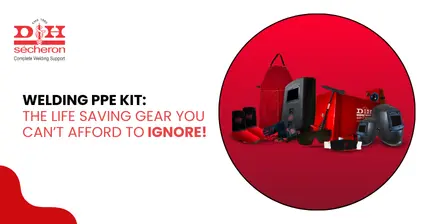The requirements for a welding technique can be long. Only a few techniques can meet those requirements, but flux-cored arc welding is a top choice. A combination of strength and precision makes it a significant contribution to various heavy-duty industries like shipbuilding, construction, and manufacturing.
What are the Advantages of Flux Cored Arc Welding?
FCAW is a continuous hollow electrode filled with flux that makes a protective shield around the weld in the welding process. This welding technique provides various advantages. Some of the most notable ones are:
1. High Welding Speed
Compared to traditional arc welding methods, Flux Cored Arc Welding or FCAW has faster deposition rates. This increases speed, a crucial element in large-scale projects typical of heavy-duty industries. It reduces labor costs and shortens project timelines, making it an efficient option.
2. Deep Penetration and Strong Welds
Flux-cored arc welding can penetrate welds deeply, even when used on thick materials. This characteristic ensures weld integrity is maintained and makes the finished project reliable for a long time.
3. Effective Welding for Outdoor Use
It is an extremely versatile technique that can be used in all positions, from vertical to overhead. This allows it to be effectively used in outdoor projects, such as construction, where there might be requirements for different welding orientations. Thanks to its self-shielding quality, it is even perfect for windy outdoor use.
4. Minimal Pre-Cleaning Required
When working with welding materials, extreme care is generally advised to prevent contamination. However, that is not the case with flux-cored wires. The base metal is much more resistant to rust and dirt, resulting in a significant reduction in welder preparation time.
5. Cost and Material Efficiency
Flux-cored arc welding reduces overall welding costs by minimizing the amount of consumables required and waste material generated. It also consumes less energy than other welding processes. The process also proves its mantle after the weld completion as it requires less cleanup afterward.
Comparison with Other Arc Welding Techniques
Compared to other welding types, its advantages stand out clearly. Flux-cored arc welding has higher deposition rates than Metal Inert Gas Welding (MIG welding). Compared to Shielded Metal Arc Welding (SMAW), it is a swifter option. And unlike Tungsten Inert Gas Welding (TIG welding), it is easier to learn, making it a beginner-friendly choice.
Conclusion
With its various benefits, flux-cored arc welding is easily the best pick for a heavy-duty welding project. It offers flexibility in usage, reduces costs, and saves time while offering excellent weld quality. To support this welding technique, investing in quality welding materials and improving the chances of success is a good rule of thumb. You can start browning for those at our website and reach out for further expert consultation to make your welding project a success!
11 May 2025 | Welding
An In-Depth Exploration of Low-Alloy Steel: Your Comprehensive Guide
11 May 2025 | Welding
Nagpur - Bori - Tuljapur Road MSH-3 in Yavatmal District (Maharashtra)
11 May 2025 | Welding
Guidelines to Understand Gas Welding: Applications, Advantages & Disadvantages
11 May 2025 | Welding
3 Tips for Finding the Best Mild Steel Electrode for Your Application
11 May 2025 | Welding
How to Select the Right Welding Filler Wires for Stainless Steel Welding?
11 May 2025 | Welding
Building the Narendra Modi Stadium with Norma V and Autotherme-1 Electrodes
11 May 2025 | Welding
Low Alloy Steel Welding in a (PEB) Pre Engineered Building Structure
11 May 2025 | Welding
Welding Rods: Different Types and Tips for Properly Storing and Handling
11 May 2025 | Welding
Tips for Flawless Welds with Stainless Steel Electrodes: Pros and Cons
11 May 2025 | Welding
Exploring Applications and Benefits of Stainless Steel Welding Electrodes
11 May 2025 | Welding
Welding Basics: Joining Metals with Heat and Pressure - A Beginners Guide
11 May 2025 | Welding
Distinguishing Low-Alloy Steel from High-Alloy Steel: Understanding the Variations
11 May 2025 | Welding
Hard Facing Wire - Understanding the Process and Achieving Optimal Result
11 May 2025 | Welding
Exploring the Advantages of Stainless Steel Electrodes in Welding Applications
11 May 2025 | Welding
Weathering Steel vs. Traditional Steel: A Comparative Analysis of Performance
11 May 2025 | Welding
Choosing the Right Welding Rod: Why 6013 Electrodes Might Be Your Ideal Option
11 May 2025 | Welding
Why 7018 Electrodes Are Preferred for High-Strength Welds in Pipeline Construction
11 May 2025 | Welding
Filler Wire vs. Stainless Steel Filler Wire: Understanding the Key Differences
11 May 2025 | Welding
Exploring the Impact of Filler Material on Welding Quality and Durability
11 May 2025 | Welding
Choosing the Right Cast Iron Electrode for Different Welding Projects
11 May 2025 | Welding
Top Advantages of Cast Iron Electrodes for Industrial Welding Applications
11 May 2025 | Welding
Key Benefits and Challenges of Using TIG Welding in Industrial Projects
11 May 2025 | Welding
5 Reasons Why 7018 Electrode is the Gold Standard for Welding Professionals
11 May 2025 | Welding
Lotherme-601: A Game-Changer for Restoring Shoulder Pins in Heavy Machinery
11 May 2025 | Welding
How D&H Sécheron Helped Repair a Rotary Kiln’s Cooler Section with LoTherme 352
11 May 2025 | Welding
Piston Repair for Mining Industry: Cost-Effective Solutions with LoTherme 468.webp)






.jpg)








































.jpg)
.jpg)

.jpg)

.jpg)





.jpg)
.jpg)
.jpg)



.webp)
.jpg)
.jpg)
.webp)
.jpg)






















.png)



.webp)

.webp)
.webp)



